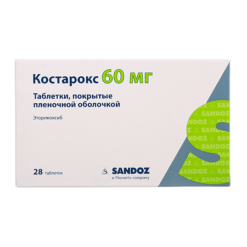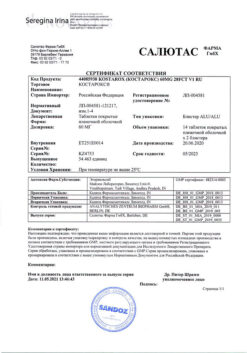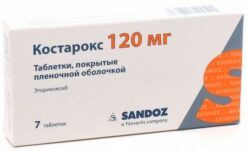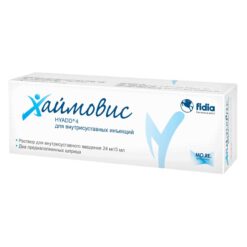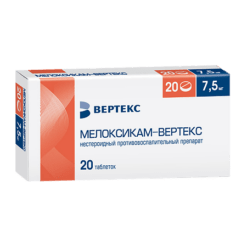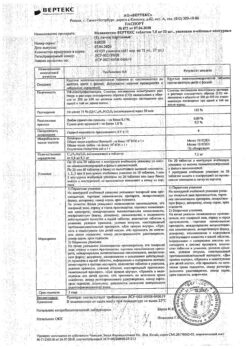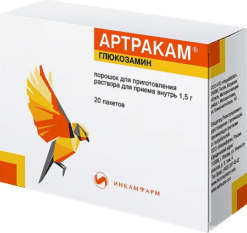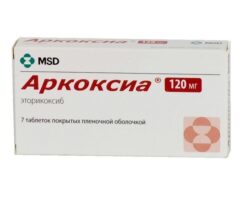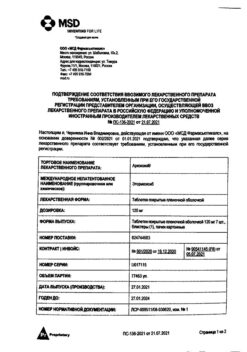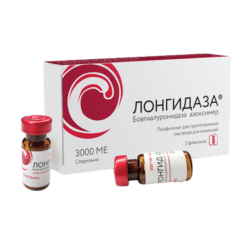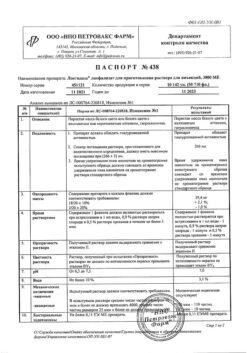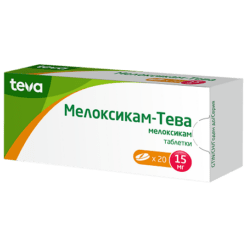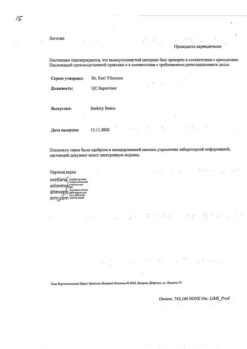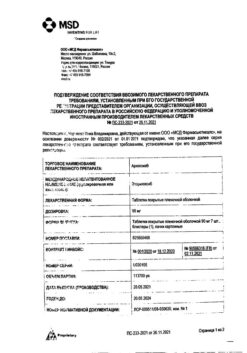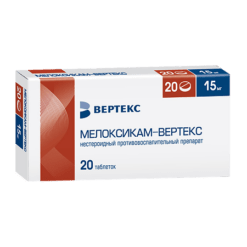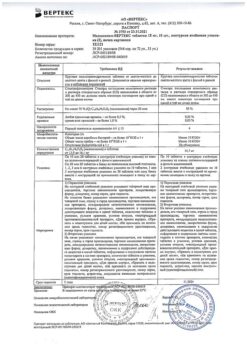No products in the cart.
Kostarox, 90 mg 28 pcs.
€25.27 €21.06
Description
NSAIDs. Selective COX-2 inhibitor, in therapeutic concentrations blocks formation of prostaglandins and has anti-inflammatory, analgesic and antipyretic effects. Selective inhibition of COX-2 is accompanied by a decrease in the severity of clinical symptoms associated with the inflammatory process, with no effect on platelet function and gastrointestinal mucosa.
Etoricoxib has a dose-dependent effect on COX-2 inhibition with no effect on COX-1 when used in daily doses up to 150 mg. It has no effect on the production of prostaglandins in the gastric mucosa and on bleeding time. In the conducted studies, no reduction in arachidonic acid levels and collagen-induced platelet aggregation was observed.
Pharmacokinetics
After oral administration it is rapidly absorbed from the gastrointestinal tract. Bioavailability when taken orally is about 100%. After adults on an empty stomach at a dose of 120 mg, Cmax is 3.6 mcg/ml, Tmax is 1 hour after intake. Food intake has no significant effect on the severity and absorption rate of etoricoxib at a dose of 120 mg. At the same time, Cmax values are decreased by 36% and Tmax is increased by 2 h. The geometric mean AUC0-24 was 37.8 µg x h/ml. The pharmacokinetics of etoricoxib within therapeutic doses is linear.
The binding to plasma proteins exceeds 92%. Vd in equilibrium is about 120 l. Etoricoxib penetrates through the placental and the HEB.
Intensively metabolized in the liver, with the participation of cytochrome P450 isoenzymes and the formation of 6-hydroxymethyl etoricoxib. Five metabolites of etoricoxib have been detected, the main ones being 6-hydroxymethyl-etoricoxib and its derivative, 6-carboxy-acetyl-etoricoxib. The main metabolites have no effect on COX-1 and are inactive or inactive against COX-2.
Extracted by the kidneys as metabolites. Less than 1% is excreted unchanged in the urine.
In a single intravenous injection, 70% is excreted by the kidneys, 20% is excreted through the intestine, mainly as metabolites. Less than 2% is found unchanged.
The equilibrium state is reached after 7 days at a daily dose of 120 mg, with a cumulation factor of about 2, which corresponds to a T1/2 of about 22 hours. Plasma clearance is approximately 50 ml/min.
In patients with mild hepatic impairment (Child-Pugh score of 5-6) a single dose of etoricoxib at 60 mg/day was associated with a 16% increase in AUC compared to healthy subjects.
In patients with moderate hepatic impairment (Child-Pugh score 7-9) who received the drug in a dose of 60 mg every other day, the AUC was the same as in healthy subjects who took the drug daily in the same dose.
Hemodialysis had little effect on excretion (dialysis clearance was approximately 50 mL/min).
Indications
Indications
Symptomatic treatment of osteoarthritis, rheumatoid arthritis, ankylosing spondylitis; pain and inflammatory symptoms associated with acute gouty arthritis; short-term treatment of pain associated with dental surgery.
Pharmacological effect
Pharmacological effect
NSAIDs. A selective COX-2 inhibitor, in therapeutic concentrations, blocks the formation of prostaglandins and has anti-inflammatory, analgesic and antipyretic effects. Selective inhibition of COX-2 is accompanied by a decrease in the severity of clinical symptoms associated with the inflammatory process, while there is no effect on platelet function and the gastrointestinal mucosa.
Etoricoxib has a dose-dependent effect of inhibiting COX-2, without affecting COX-1 when used in a daily dose of up to 150 mg. It has no effect on the production of prostaglandins in the gastric mucosa and on bleeding time. In the studies conducted, there was no decrease in arachidonic acid levels and platelet aggregation caused by collagen.
Pharmacokinetics
After oral administration, it is quickly absorbed from the gastrointestinal tract. Bioavailability when taken orally is about 100%. After administration by adults on an empty stomach at a dose of 120 mg, Cmax is 3.6 mcg/ml, Tmax is 1 hour after administration. Food intake does not have a significant effect on the severity and rate of absorption of etoricoxib when taken at a dose of 120 mg. At the same time, Cmax values decrease by 36% and Tmax increases by 2 hours. The geometric mean value of AUC0-24 was 37.8 μg x h/ml. The pharmacokinetics of etoricoxib within therapeutic doses is linear.
Plasma protein binding exceeds 92%. Vd at equilibrium is about 120 l. Etoricoxib crosses the placental and blood-brain barrier.
Intensively metabolized in the liver, with the participation of cytochrome P450 isoenzymes and the formation of 6-hydroxymethyl-etoricoxib. Five metabolites of etoricoxib were discovered, the main ones being 6-hydroxymethyl-etoricoxib and its derivative 6-carboxy-acetyl-etoricoxib. The main metabolites do not affect COX-1 and are completely inactive or have little activity against COX-2.
Excreted by the kidneys in the form of metabolites. Less than 1% is excreted unchanged in the urine.
With a single intravenous administration, 70% is excreted by the kidneys, 20% through the intestines, mainly in the form of metabolites. Less than 2% was found unchanged.
The equilibrium state is achieved after 7 days with a daily dose of 120 mg, with a cumulation coefficient of about 2, which corresponds to T1/2 – about 22 hours. Plasma clearance is approximately 50 ml/min.
In patients with mildly impaired liver function (Child-Pugh score 5-6), a single dose of etoricoxib at a dose of 60 mg/day was accompanied by an increase in AUC by 16% compared to healthy individuals.
In patients with moderate hepatic impairment (Child-Pugh score 7-9) taking the drug at a dose of 60 mg every other day, the AUC value was the same as in healthy individuals taking the drug daily at the same dose.
Hemodialysis had little effect on excretion (dialysis clearance – about 50 ml/min).
Special instructions
Special instructions
Use with caution when there is a history of ulcerative lesions of the gastrointestinal tract, Helicobacter pylori infection, in the elderly, in patients who have been receiving NSAIDs for a long time, with severe somatic diseases, dyslipidemia/hyperlipidemia, with diabetes mellitus, arterial hypertension, edema and fluid retention, smoking, in patients with CC less than 60 ml/min, with concomitant therapy with the following drugs: anticoagulants (for example, warfarin), antiplatelet agents (for example, acetylsalicylic acid, clopidogrel), corticosteroids (for example, prednisolone), selective serotonin reuptake inhibitors (for example, citalopram, fluoxetine, paroxetine, sertraline), for chronic alcoholism.
During the treatment period, careful monitoring of blood pressure is required during the first 2 weeks and periodically thereafter.
During treatment, liver and kidney function indicators should be regularly monitored. If the activity of liver transaminases increases by 3 times or more relative to ULN, treatment should be discontinued.
Given the increasing risk of adverse effects with increasing duration of use, it is necessary to periodically evaluate the need to continue treatment and the possibility of dose reduction.
Should not be used simultaneously with other NSAIDs.
Impact on the ability to drive vehicles and operate machinery
During the treatment period, care must be taken when driving vehicles and engaging in other potentially hazardous activities that require increased concentration and speed of psychomotor reactions. Patients who have experienced episodes of dizziness, drowsiness or weakness should refrain from activities requiring concentration.
Active ingredient
Active ingredient
Etoricoxib
Composition
Composition
1 tab.:
Contraindications
Contraindications
Complete or incomplete combination of bronchial asthma, recurrent polyposis of the nose or paranasal sinuses and intolerance to acetylsalicylic acid and other NSAIDs (including a history).
Erosive and ulcerative changes in the mucous membrane of the stomach or duodenum, active gastrointestinal bleeding, cerebrovascular or other bleeding.
Inflammatory bowel diseases (Crohn’s disease, ulcerative colitis) in the acute phase.
Hemophilia and other bleeding disorders.
Severe heart failure (II-IV functional classes according to the NYHA classification).
Severe liver failure (more than 9 points on the Child-Pugh scale) or active liver disease.
Severe renal failure (creatinine clearance less than 30 ml/min), progressive kidney disease, confirmed hyperkalemia.
The period after coronary artery bypass surgery; peripheral arterial diseases, cerebrovascular diseases, clinically significant ischemic heart disease.
Sustained arterial hypertension with blood pressure values more than 140/90 mm Hg. Art.
Pregnancy, lactation (breastfeeding).
Children and teenagers up to 16 years of age.
Hypersensitivity to etoricoxib.
Side Effects
Side Effects
From the digestive system: often – epigastric pain, nausea, diarrhea, dyspepsia, flatulence; sometimes – bloating, belching, increased peristalsis, constipation, dry oral mucosa, gastritis, ulcer of the gastric or duodenal mucosa, irritable bowel syndrome, esophagitis, ulcers of the oral mucosa, vomiting; very rarely – gastrointestinal ulcers (with bleeding or perforation), hepatitis.
From the nervous system: often – headache, dizziness, weakness; sometimes – taste disturbance, drowsiness, sleep disturbances, sensory disturbances, incl. paresthesia/hyperesthesia, anxiety, depression, concentration disorders; very rarely – hallucinations, confusion.
From the senses: sometimes – blurred vision, conjunctivitis, tinnitus, vertigo.
From the urinary system: sometimes – proteinuria; very rarely – renal failure, usually reversible when the drug is discontinued.
Allergic reactions: very rarely – anaphylactic/anaphylactoid reactions, including a pronounced decrease in blood pressure and shock.
From the cardiovascular system: often – palpitations, increased blood pressure; sometimes – hot flashes, cerebrovascular accident, atrial fibrillation, congestive heart failure, nonspecific ECG changes, myocardial infarction; very rarely – hypertensive crisis.
From the respiratory system: sometimes – cough, shortness of breath, nosebleeds; very rarely – bronchospasm.
Dermatological reactions: often – ecchymosis; sometimes – swelling of the face, itching, rash; very rarely – urticaria, Stevens-Johnson syndrome, Lyell’s syndrome.
Infectious complications: sometimes – gastroenteritis, infections of the upper respiratory tract, urinary tract.
From the musculoskeletal system: sometimes – muscle cramps, arthralgia, myalgia.
Metabolism: often – swelling, fluid retention; sometimes – changes in appetite, weight gain.
From laboratory tests: often – increased activity of liver transaminases; sometimes – increased nitrogen in the blood and urine, increased CPK activity, decreased hematocrit, decreased hemoglobin, hyperkalemia, leukopenia, thrombocytopenia, increased serum creatinine, increased uric acid; rarely – increased sodium in the blood serum.
Other: often – flu-like syndrome; sometimes – pain in the chest.
Manufacturer
Manufacturer
Cadila Pharmaceuticals Ltd, India
Additional information
| Manufacturer | Kadila Pharmaceuticals Ltd, India |
|---|---|
| Medication form | pills |
| Brand | Kadila Pharmaceuticals Ltd |
Other forms…
Related products
Buy Kostarox, 90 mg 28 pcs. with delivery to USA, UK, Europe and over 120 other countries.



